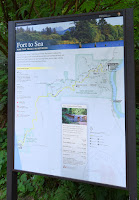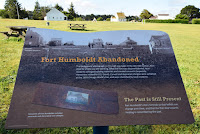One of the first things I like to do when moving to a new state (right after
ordering a book about the state history) is to join the state historical society. State historical societies usually have a pretty comprehensive museum, plus I like to get their journal.
The Oregon Historical Society is located in downtown Portland. I have not visited yet, first I have to get over my dread of Portland traffic and parking. However, I'm looking forward to checking it out and promise to post some pictures when we visit later this summer. I joined the society ahead of our visit by visiting their website. For $80 I signed up for a family membership for the year. That might sound like a lot but their are benefits. Along with free admission to the museum for two adults and as many children as you have living in your house, you also get a
quarterly journal. A few of the articles are posted online so you can see the quality and depth of the publication, but once you join you have access to past issues online through the website (so no need for that JSTOR account). With membership you can also participate in the area "
reciprocal membership program." Each month, one of the participating museums admits members of the other museums for free. So if I had been a member of the Oregon Historical Society last month when we visited the
Columbia River Maritime Museum in Astoria while on vacation, we would have saved twenty-eight bucks! And best of all, your membership fee helps the society continue their good work of preserving the state's history through the museum and archive.
One of the things I hate to see is when a museum or historic site charges what I consider to be too high of an entrance fee. I want to see these sites available to everyone, regardless of means. Along with the entry fee, I support every site I visit by buying a book or some kind of souvenir in the gift shop (Sheila collects refrigerator magnets to keep track of where we've been) and I might even drop a couple of dollars in the donation box as well. Now I get it, to run a quality museum takes funds, and sometimes donations just aren't fulfilling the need. But anyone who took economics can tell you that when you raise the price, you might make more money up to a certain price point, but with each increase in entry fee you are going to lose some visitors. I hate the thought of a young person being denied the experience of visiting a museum because they did not have the means to pay the entry fee.
So here's my final point of why I'm praising the Oregon Historical Society before I've even visited the museum. The entry fee is only five dollars. It was a bleeding fourteen dollars at the maritime museum, so for a state museum five bucks sounds like a bargain to me. Moreover, they participate in the "
Museums for All" program. Museums for all is "a signature access program that encourages families of all backgrounds to visit museums regularly and build lifelong museum habits." In other words, let's remove the obstacle of cost, and get kids visiting museums with their families. With this program, all visitors have to do is present a valid
EBT card along with a picture ID and up to a family of four can visit the museum for free. I love this program and I'm proud to support it with my membership.
------------------------------------------------------------------------------------------------------------------


We are enjoying our new home in Salem, Oregon very much. I'm getting up to speed on the local history. But I wanted to let you know that I took on the challenge of reading
"Grant" by Ron Chernow. The reason I call it a challenge is that it is 929 pages not including front and back matter. I'm about a third through it and it is worth the investment of time so far. I'm pretty ignorant of Grant's contributions as President, so I'm looking forward to getting to that part of the book.
That's all for this post. I hope you're visiting some exciting history sites and reading some good books. Recommendations are welcome. ;-)







































